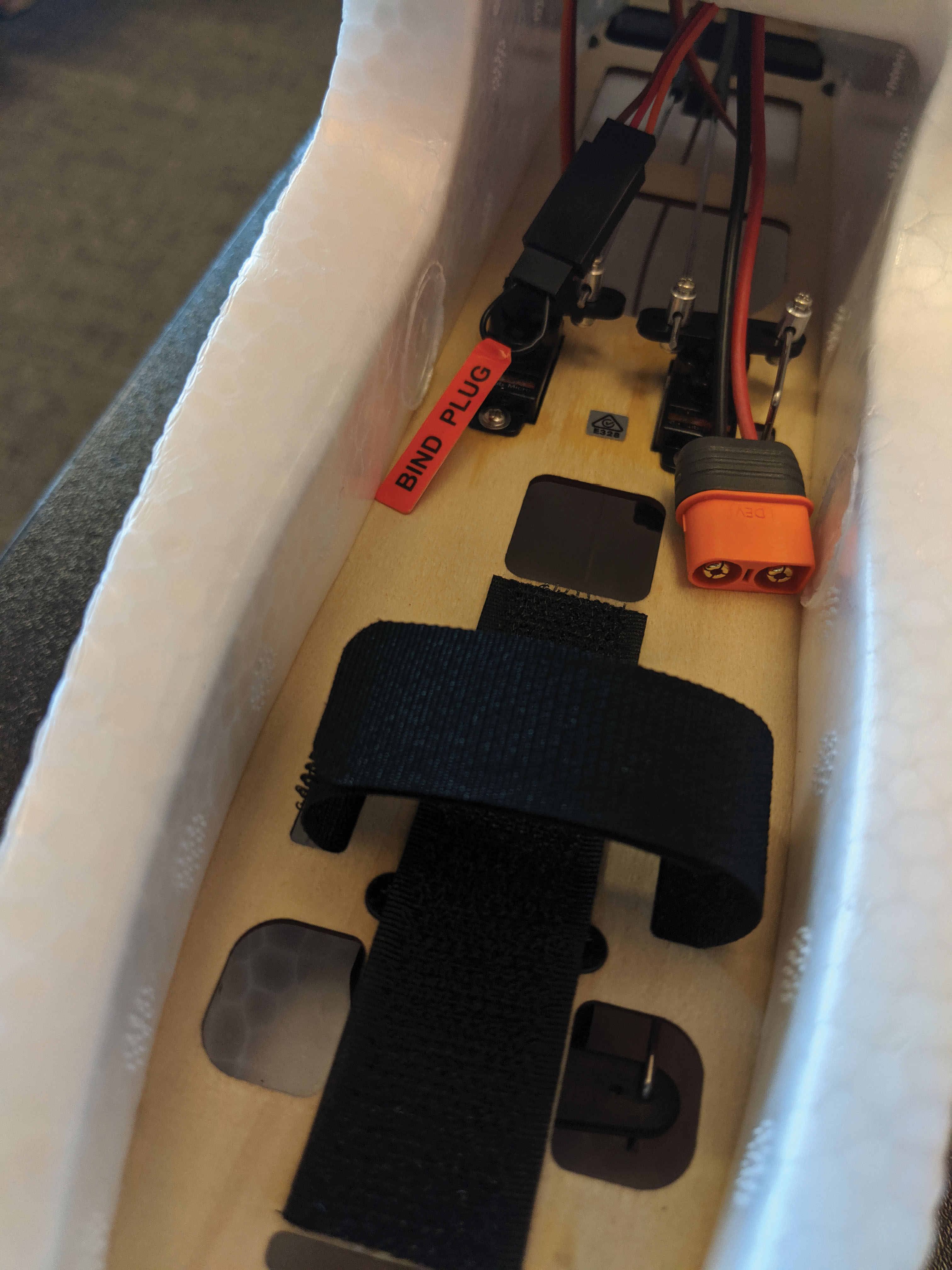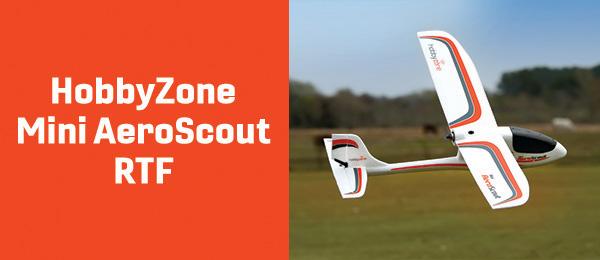
Written by Kyle Jaracz Form follows function, which equals fun! As seen in the Winter 2020 issue of Park Pilot
SPECIFICATIONS:
Type: Trainer Skill level: Beginner Wingspan: 43.1 inches Length: 34.25 inches Ready-to-fly weight: 27.8 to 29.5 ounces Price: $199.99 Info: horizonhobby.com
Features:
- 100% complete including a Spektrum DXe controller/transmitter, battery, and charger
- Beginner, Intermediate, and Experienced flight modes
- Panic Recovery function

Here’s what is included in the box. You’ll have it put together before the battery is done charging, so take your time and read the manual, which will set you up for success.
>> I’m a bit snobbish when it comes to the look of an aircraft. Sometimes my love of scale aircraft, with their classic lines and instantaneous nostalgia, draw me in more than the models’ flight characteristics and capabilities. As such, when I first encountered the Horizon Hobby AeroScout during the evening flying at EAA’s AirVenture (eaa.org/en/airventure) in 2019, I wasn’t overly enthusiastic to give it a chance … boy was I selling this trainer short. Before I get into the model’s flight characteristics and why I believe it is a perfect fit for new pilots, let me start with the build process. Horizon Hobby knows a thing or three about how a model aircraft should go together, and the company has created a simple process to get this out of the box and into the air. The included manual is informative and easy to understand. There’s even a single-sheet guide to quickly put together the airframe for those who might be unable to contain their excitement and want to assemble it as quickly as possible. I had it assembled in less than 15 minutes. No glue is required, and the only time you will need the included screwdriver is when you affix the nose gear using a single screw. I added a drop of blue Loctite threadlocker to the front gear screw to keep it from working loose. 
The AeroScout comes with everything you need to successfully navigate the sky.
The binding process to pair the included DXe transmitter is outlined in the manual. You’ll have access to the powerful SAFE (Sensor Assisted Flight Envelope) technology by utilizing the top left switch. You can easily move from Beginner, to Intermediate, then Experienced mode. By doing so, you can safely and effectively advance your skillset while always having a safety net in place via the Panic Recovery button. If you get disoriented in any of the modes and press that button, the aircraft will attempt to return to neutral level flight. You can also link the radio to many other Spektrum transmitters as a buddy-box system so another pilot can learn to fly while having an experienced instructor available to take some of the pressure off. After you’ve read the manual, charged the included battery, confirmed the CG (center of gravity), and bound the radio, you can begin your first flight. You shouldn’t need to worry too much about breaking a propeller because the pusher configuration protects it. The aircraft’s large tires accommodate a range of field conditions.

The battery compartment is roomy, but remember to check your CG and ensure that the control horns and canopy latch are unimpeded.
I’ve heard that some pilots have had good results with the AeroScout in a belly-landing configuration to save a bit of weight or if they have tall grass with which to contend. If you do so, you should protect the bottom of the aircraft by adding a piece of polystyrene, or at the very least, covering the front servo with something to protect it during nose-forward landings. I also recommend that you reconfirm your CG after such a landing. I chose to use the landing gear on mine. Be cognizant of where you place the battery pack and avoid any potential interference with the servos at the aft side of the tray and the canopy latch at the front of the airframe. With the “always on” AS3X technology contained in this aircraft, I’ve found the CG to be fairly forgiving. This allows you to utilize a broad range of battery packs. For beginners, the included 3S 2,200 mAh LiPo will do just fine and enable you to learn at a slower pace. Ground handling is smooth, and there is enough control throw to taxi easily and effectively. Rollout under power was great, and before 20 feet had gone by, I was in the air. Flying with SAFE technology is as you’d expect. The controls are smooth, and this aircraft is surprisingly responsive! This is aided in part by the motor’s pusher configuration. This allows greater direct airflow over the control surfaces, which equals greater control. This airplane does a great job of gliding. Be prepared to make a few go-arounds when learning to set up your landings. I changed to Intermediate mode and was pleased with the results. I recommend doing most of your learning using this mode because it allows you to develop the corrective actions of self-leveling your aircraft after banking or pitching. When you’ve mastered this, you can move to the Experienced mode, knowing that if you become disoriented, you can hit the panic button. When set at Experienced mode, I was able to perform loops, rolls, and inverted flight, but even in high rates, I didn’t have quite enough control to feel comfortable flying inverted. As you progress, you can add a bit of control to these surfaces by adjusting the servo linkages. I highly recommend this aircraft to be used as a first trainer to intermediate flier. Once you get past the aesthetics, you’ll realize the beauty that the AeroScout holds by doing what it’s supposed to do very well! The form follows function on this aircraft and as a trainer, it’s one that I now recommend across the board. In fact, I had two of them under the Christmas tree for my boys!

Flights are smooth, and the aircraft’s response to inputs is snappy. This trainer flies great!
Written by Kyle Jaracz | [email protected]






